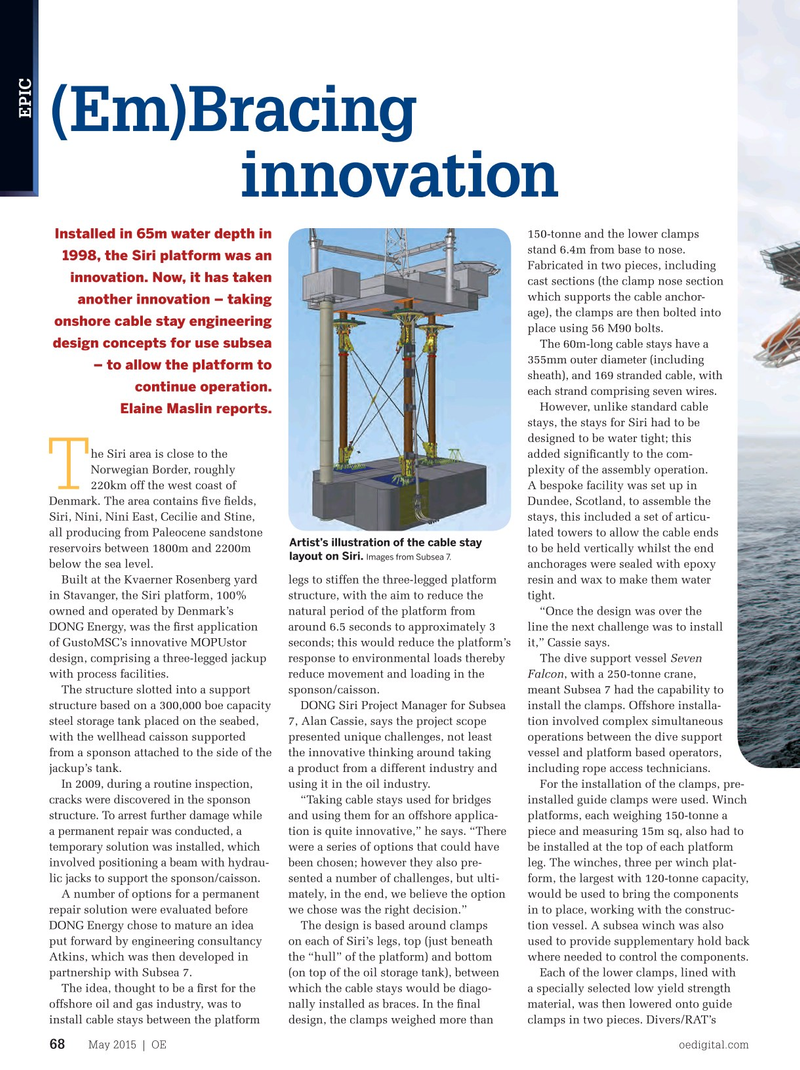
Page 66: of Offshore Engineer Magazine (May/Jun 2015)
Read this page in Pdf, Flash or Html5 edition of May/Jun 2015 Offshore Engineer Magazine
EPIC (Em)Bracing innovation 150-tonne and the lower clamps
Installed in 65m water depth in stand 6.4m from base to nose. 1998, the Siri platform was an
Fabricated in two pieces, including innovation. Now, it has taken cast sections (the clamp nose section which supports the cable anchor- another innovation – taking age), the clamps are then bolted into onshore cable stay engineering place using 56 M90 bolts.
design concepts for use subsea
The 60m-long cable stays have a 355mm outer diameter (including – to allow the platform to sheath), and 169 stranded cable, with continue operation. each strand comprising seven wires.
However, unlike standard cable
Elaine Maslin reports.
stays, the stays for Siri had to be designed to be water tight; this he Siri area is close to the added signifcantly to the com-
Norwegian Border, roughly plexity of the assembly operation.
T 220km off the west coast of A bespoke facility was set up in
Denmark. The area contains fve felds, Dundee, Scotland, to assemble the
Siri, Nini, Nini East, Cecilie and Stine, stays, this included a set of articu- all producing from Paleocene sandstone lated towers to allow the cable ends
Artist’s illustration of the cable stay reservoirs between 1800m and 2200m to be held vertically whilst the end layout on Siri. Images from Subsea 7.
below the sea level. anchorages were sealed with epoxy
Built at the Kvaerner Rosenberg yard legs to stiffen the three-legged platform resin and wax to make them water in Stavanger, the Siri platform, 100% structure, with the aim to reduce the tight.
owned and operated by Denmark’s natural period of the platform from “Once the design was over the
DONG Energy, was the frst application around 6.5 seconds to approximately 3 line the next challenge was to install of GustoMSC’s innovative MOPUstor seconds; this would reduce the platform’s it,” Cassie says. design, comprising a three-legged jackup response to environmental loads thereby The dive support vessel Seven with process facilities. reduce movement and loading in the Falcon, with a 250-tonne crane,
The structure slotted into a support sponson/caisson. meant Subsea 7 had the capability to structure based on a 300,000 boe capacity DONG Siri Project Manager for Subsea install the clamps. Offshore installa- steel storage tank placed on the seabed, 7, Alan Cassie, says the project scope tion involved complex simultaneous with the wellhead caisson supported presented unique challenges, not least operations between the dive support from a sponson attached to the side of the the innovative thinking around taking vessel and platform based operators, jackup’s tank. a product from a different industry and including rope access technicians.
In 2009, during a routine inspection, using it in the oil industry. For the installation of the clamps, pre- cracks were discovered in the sponson “Taking cable stays used for bridges installed guide clamps were used. Winch structure. To arrest further damage while and using them for an offshore applica- platforms, each weighing 150-tonne a a permanent repair was conducted, a tion is quite innovative,” he says. “There piece and measuring 15m sq, also had to temporary solution was installed, which were a series of options that could have be installed at the top of each platform involved positioning a beam with hydrau- been chosen; however they also pre- leg. The winches, three per winch plat- form, the largest with 120-tonne capacity, sented a number of challenges, but ulti- lic jacks to support the sponson/caisson. installed the upper and lower bolts and would be used to bring the components mately, in the end, we believe the option A number of options for a permanent then an automated bolt rack was used in to place, working with the construc- we chose was the right decision.” repair solution were evaluated before to locate and tighten the remaining 46 tion vessel. A subsea winch was also The design is based around clamps DONG Energy chose to mature an idea bolts (each bolt 90mm-diameter, 2m-long used to provide supplementary hold back on each of Siri’s legs, top (just beneath put forward by engineering consultancy and weighing 300kg), creating a metal to where needed to control the components. the “hull” of the platform) and bottom Atkins, which was then developed in metal grip between the clamp and the leg
Each of the lower clamps, lined with (on top of the oil storage tank), between partnership with Subsea 7. tubular.
a specially selected low yield strength which the cable stays would be diago- The idea, thought to be a frst for the Next, the upper clamps were installed. material, was then lowered onto guide nally installed as braces. In the fnal offshore oil and gas industry, was to “The subsea installation tolerances were clamps in two pieces. Divers/RAT’s design, the clamps weighed more than install cable stays between the platform very tight. The upper clamps required a
May 2015 | OE oedigital.com 68 068_OE0515_EPIC1-Siri.indd 68 4/20/15 3:42 PM

 65
65

 67
67